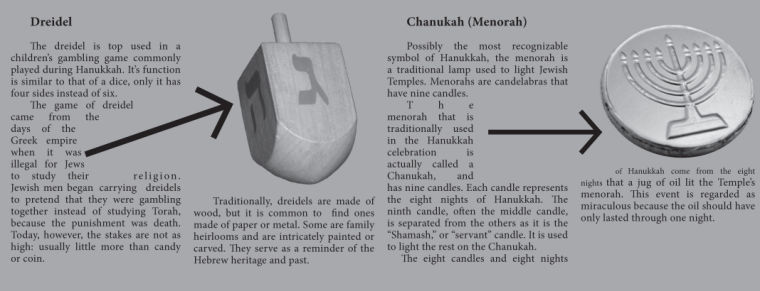Hanukkah, Chanukah, Festival of Lights
December 2, 2009
This year the Jewish Festival of Lights will begin with a candle lighting before sunset Friday, Dec. 11. The celebration begins on the 25th day of the Jewish month of Kislev. The spelling of Hanukkah has been changed to make it more phonetic in English. The more traditional spelling is “Chanukah.” The “ch” is a throaty guttural sound that does not exist in English.
Hanukkah celebrates the victory of the Jewish Maccabees against the idol-worshiping Syrian-Greeks in 165 BCE (before common era, the Hebrew equivalent of B.C.). Under pressure to adopt idol worship, they fought and won a prolonged guerilla campaign in Israel, evicting their enemies and restoring the Temple. According to the Talmud (text of Rabbinic teachings), after the Temple had been cleaned and the priests were ready to light the menorah, there was only one jug of the required pure olive oil fit to use. One jug should have only lasted one day, but it miraculously lasted eight, which is why Hanukkah lasts eight days. The menorah is lit to celebrate the victory and the miracle of lights.
The lighting and prominent display of the Menorah is a public affirmation to the world that God makes miracles for those who stand up for truth and justice. It represents the defeat of darkness with light, one for each day of the miracle. The original Menorahs were made of clay with eight wicks fueled by sacred olive oil. Modern candelabra style menorahs have nine or seven branches. The middle one holds the candle that is used to light the rest.
Electric Menorahs are allowed for decoration, but an old-fashioned one, oil or candle, is required to fulfill the Mitzvah, or commandment. Prayers and hymns accompany the lighting of the menorah.
Hanukkah is a family event where stories, food and playing with the dreidel follow the lighting ceremony. As a further reminder of the oil miracle the traditional foods are cooked in oil. Latkes are potato pancakes made from grated potatoes blended with eggs, onions, and flour, then fried crisp in vegetable oil. Sufganiyot are similar to jelly doughnuts. They are free formed and fried in hot oil, then covered in powdered sugar or cinnamon.
The dreidel is a four-sided wooden top that was actually used for subterfuge during the time when Greek soldiers killed anyone studying the Torah. If soldiers approached a group of Jews studying the holy scripture, it was hidden and the top was produced to fool the soldiers into thinking that the men had gathered to gamble rather than study. There are four Hebrew letters on the sides of the top. When it stops spinning, the letter that lands face up indicates whether the player will win, lose, void or take half from the kitty. Today it is spun by children to play for coins and candy.
During Hanukkah it is customary to give gelt, or money, to children. The custom is based on the practice of giving candle money to the poor so that they may honor the Mitzvah. It is practiced today so that children may learn charity.
he last day of Hanukkah will be Friday, Dec. 18. Prayers will be recited and all eight lights of the menorah will be lit before sunset. Shalom.



